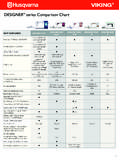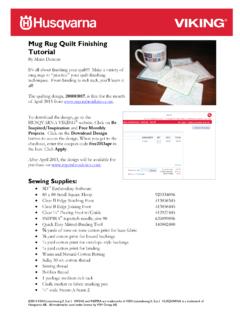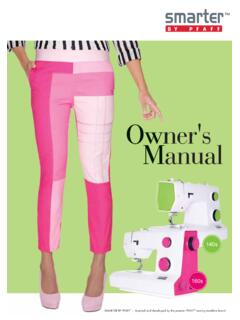Transcription of USER’S GUIDE
1 USER'S GUIDE . E10. This household sewing machine is designed to comply with IEC/EN 60335-2-28 and UL1594. IMPORTANT SAFETY INSTRUCTIONS. When using an electrical appliance, basic safety precautions should always be followed, including the following: Read all instructions before using this household sewing machine. DANGER - To reduce the risk of electric shock: A sewing machine should never be left unattended when plugged in. Always unplug this sewing machine from the electric outlet immediately after using and before cleaning. WARNING - To reduce the risk of burns, re, electric shock, or injury to persons: This sewing machine is not intended for use by persons (including children) with reduced physical, sensory or mental capabilities, or lack of experience and knowledge, unless they have been given supervision or instruction concerning use of the sewing machine by a person responsible for their safety. Children should be supervised to ensure that they do not play with the sewing machine.
2 Use this sewing machine only for its intended use as described in this manual. Use only attachments recommended by the manufacturer as contained in this manual. Never operate this sewing machine if it has a damaged cord or plug, if it is not working properly, if it has been dropped or damaged, or dropped into water. Return the sewing machine to the nearest authorized dealer or service center for examination, repair, electrical or mechanical adjustment. Never operate the sewing machine with any air openings blocked. Keep ventilation openings of the sewing machine and foot controller free from the accumulation of lint, dust, and loose cloth. Keep ngers away from all moving parts. Special care is required around the sewing machine needle. Always use the proper needle plate. The wrong plate can cause the needle to break. Do not use bent needles. Do not pull or push fabric while stitching. It may de ect the needle causing it to break. Switch the sewing machine off ( 0 ) when making any adjustment in the needle area, such as threading needle, changing needle, threading bobbin, or changing presser foot, etc.
3 Always unplug sewing machine from the electrical outlet when removing covers, lubricating, or when making any other user servicing adjustments mentioned in the instruction manual. Never drop or insert any object into any opening. Do not use outdoors. Do not operate where aerosol (spray) products are being used or where oxygen is being administrated. To disconnect, turn all controls to the off ( 0 ) position, then remove plug from outlet. Do not unplug by pulling on cord. To unplug, grasp the plug, not the cord. Hold plug when rewinding into cord reel. Do not allow plug to whip when rewinding. This sewing machine is provided with double insulation. Use only identical replacement instructions for Servicing of Double-Insulated Appliances. SAVE THESE INSTRUCTIONS. Please note that on disposal, this product must be safely recycled in accordance with relevant National legislation relating to electrical/electronic products. If in doubt please contact your retailer for guidance Congratulations!
4 As the owner of a new sewing machine, you will enjoy precision quality stitching on all types of fabrics, from multiple layers of denim to delicate silks. Your sewing machine offers the ultimate in simplicity and ease of operation. For your safety and to fully enjoy the many advantages and ease of operation of your sewing machine, we recommend that you read all the important safeguards and use and care instructions in this instruction book. May we suggest that before you start to use your sewing machine, you discover the many features and advantages by going through this instruction book, step by step, while seated at your sewing machine. To ensure that you are always provided with the most modern sewing capabilities, the manufacturer reserves the right to change appearance, design or accessories of this sewing machine when considered necessary. LIST OF CONTENTS. PRINCIPAL PARTS OF THE MACHINE ..5. FITTING THE SNAP-IN ACCESSORY BOX ..8.
5 CONNECTING THE MACHINE TO POWER SOURCE ..9. Foot Sewing light ..9. CHANGING THE TWO-STEP PRESSER FOOT LEVER/ADJUST PRESSER FOOT PRESSURE ..11. ATTACHING THE PRESSER FOOT SHANK/ANKLE ..12. WINDING THE BOBBIN ..13. INSERTING THE BOBBIN ..14. INSERTING THE NEEDLE ..15. THREADING THE UPPER THREAD ..16. THREAD TENSION ..17. BRINGING UP THE BOBBIN THREAD ..18. REVERSE SEWING/REMOVING THE FABRIC/CUTTING THE THREAD ..19. MATCHING NEEDLE / FABRIC / THREAD ..20. STRAIGHT STITCHING ..21. ZIGZAG STITCHING ..22. HOW TO SEW BUTTONHOLES ..23. BLIND HEM ..25. ZIPPERS AND 3-STEP ZIG-ZAG ..27. STITCH SELECTION ..28. MAINTENANCE ..29. TROUBLE SHOOTING GUIDE ..30. 4. PRINCIPAL PARTS OF THE MACHINE. 1. Thread tension dial 2. Presser foot pressure 3. Thread take-up lever 4. Thread cutting 5. Presser foot 6. Needle plate 7. Accessories box 8. Bobbin stop 9. Stitch length dial 10. Stitch display 11. Reverse sewing lever 5. 12. Spool pin 13. Bobbin winder 14. Hole for second spool pin 15.
6 Hand wheel 16. Stitch selector dial 17. Power switch 18. Main plug socket 19. Bobbin thread GUIDE 20. Upper thread GUIDE 21. Handle 22. Presser foot lever 6. ACCESSORIES. 1 2 3 4. 5 6 7. 8 9 10 11. 12 13 14 15. 1. All purpose foot 11. Pack of needles 2. Zipper foot 12. Seam GUIDE 3. Satin stitch foot 13. Bobbins (3x). 4. Blind hem foot 14. Darning plate 5 Buttonhole foot 15. Felt pad 6. L-screwdriver 7. Seam ripper/ brush 8. Oil bottle 9. Second spool pin 10. Spool holders (2x). 7. FITTING THE SNAP-IN ACCESSORY BOX. Keep the snap-in accessory box horizontal, and push it in the direction of the arrow. (1). To open, lift up at the point of the arrow. (2). 8. CONNECTING THE MACHINE TO POWER SOURCE. Connect the machine to a power source as illustrated. (1). A polarized plug must be used with the appropriate polarized outlet. (2). Attention: Unplug power cord when machine is not in use. 1. Foot control Foot control regulates the sewing speed.
7 (3). 3. Attention: Consult a quali ed electrician if in doubt as to how to connect machine to power source. Unplug power cord when machine is not in appliance must be used with the foot controller: For USA and Canada, 110-120V: KD-1902. For Australia and Europe, 220-240V: KD-2902. Sewing light Press main switch (A) for power and light on. ( l ). For USA and Canada For appliance with a polarized plug (one blade is wider than the other). To reduce the risk of electric shock, this plug is intended to t in a polarized outlet only one way. If it does not t fully in the outlet, reverse the plug. If it still does not t, contact a quali ed electrician to install the proper outlet. Do not modify the plug in any way. 9. CHANGING THE BULB. Attention:Disconnect the machine from the power supply by removing the plug from the main socket! Replace bulb with same type rated 10 watts (110-120V) or 15 watts (220-240V). - Loosen screw (A) as illustrated. (1).
8 1. - Remove the cover (B). - Unscrew the bulb and t new one (C). (2). - Replace the cover and tighten screw. Should there be any problem, ask your local dealer for advice. 2. 10. TWO-STEP PRESSER FOOT LEVER. When sewing several layers or thick fabrics, the presser foot can be raised to extra high for easy positioning of the work. (A). ADJUST PRESSER FOOT PRESSURE. The presser foot pressure of the machine has been pre-set and usually requires no Loosen Tighten presser readjustment for most fabrics (light-or-heavy weight). adjusting screw However, if you need to adjust the presser - +. foot pressure, turn the presser adjusting screw with a coin. For sewing very thin fabric, loosen the pressure by turning the screw counter clockwise for less pressure on the fabric, and for heavy fabric, tighten by turning it clockwise for more pressure on the fabric. 11. ATTACHING THE PRESSER FOOT SHANK/ ANKLE. Attaching the presser foot holder Raise the presser foot bar (a).
9 (1). Attach the presser foot shank/ankle (b) as illustrated. Attaching the presser foot Lower the presser foot shank/ankle (b) until the cut-out (c) is directly above the pin on the foot (d). (2). Raise the lever (e). Lower the presser foot shank/ankle (b) and the presser foot (f) will engage automatically. Removing the presser foot Raise the presser foot. (3). Raise the lever (e) and the foot disengages. Attaching the seam GUIDE Attach the seam GUIDE (g) in the slot on the shank/ankle as illustrated. Adjust according to need for hems, pleats, quilting, etc. (4). Attention: Turn power switch to off ( O ). when carrying out any of the above operations! 12. WINDING THE BOBBIN. Place thread and spool holder onto spool pin (1). - For smaller spools of thread place spool holder with small side next to spool (2). - Wind thread clockwise around bobbin winder tension discs (3). - Thread bobbin as illustrated and place on spindle (4). - Push bobbin to right (5).
10 - Hold thread end (6). - Step on foot control pedal (7). to wind the bobbin. - Cut thread (8). - Press bobbin to left (9) and remove. Please Note: When the bobbin winder spindle is in bobbin winding position, the machine will not sew and the hand wheel will not turn. To start sewing, push the bobbin winder spindle to the left (sewing position). 13. INSERTING THE BOBBIN. When inserting or removing the bobbin, the foot and needle must be fully raised. 1. Open the hinged cover. 2. Hold the bobbin case with one hand. Insert the bobbin so that the thread runs in a clockwise direction (arrow). 3. Put the thread under the tension spring. 4. Hold the bobbin case by the hinged latch. 5. Insert it into the shuttle. Attention: Turn power switch to off ( O ). 14. INSERTING THE NEEDLE. Change the needle regularly, especially if it is showing signs of wear and causing problems. Insert the needle following the illustrated instructions. A. Loosen the needle clamp screw and tighten again after inserting the new needle.
















